Detailed Analysis of the 2014 Ebola Epidemic in West Africa
VerifiedAdded on 2020/07/22
|11
|2885
|85
Report
AI Summary
This report provides a detailed analysis of the 2014 Ebola epidemic in West Africa, examining the causative agent, outbreak distribution, and geographic features. It explores the possibility of Ebola as a biowarfare agent and applies the Grunow and Finke criteria to assess whether the outbreak was natural or intentional. The report discusses conclusive and non-conclusive criteria, including biological risks, threats, geographic distribution peculiarities, and transmission modes. It assesses various factors, such as the intensity and dynamics of the outbreak, clinical manifestations, and the speed of spread, providing a comprehensive overview of the epidemic and its potential origins. The report aims to determine if the Ebola outbreak in West Africa was a natural occurrence or if it was deliberately initiated by external bodies using an infectious agent.
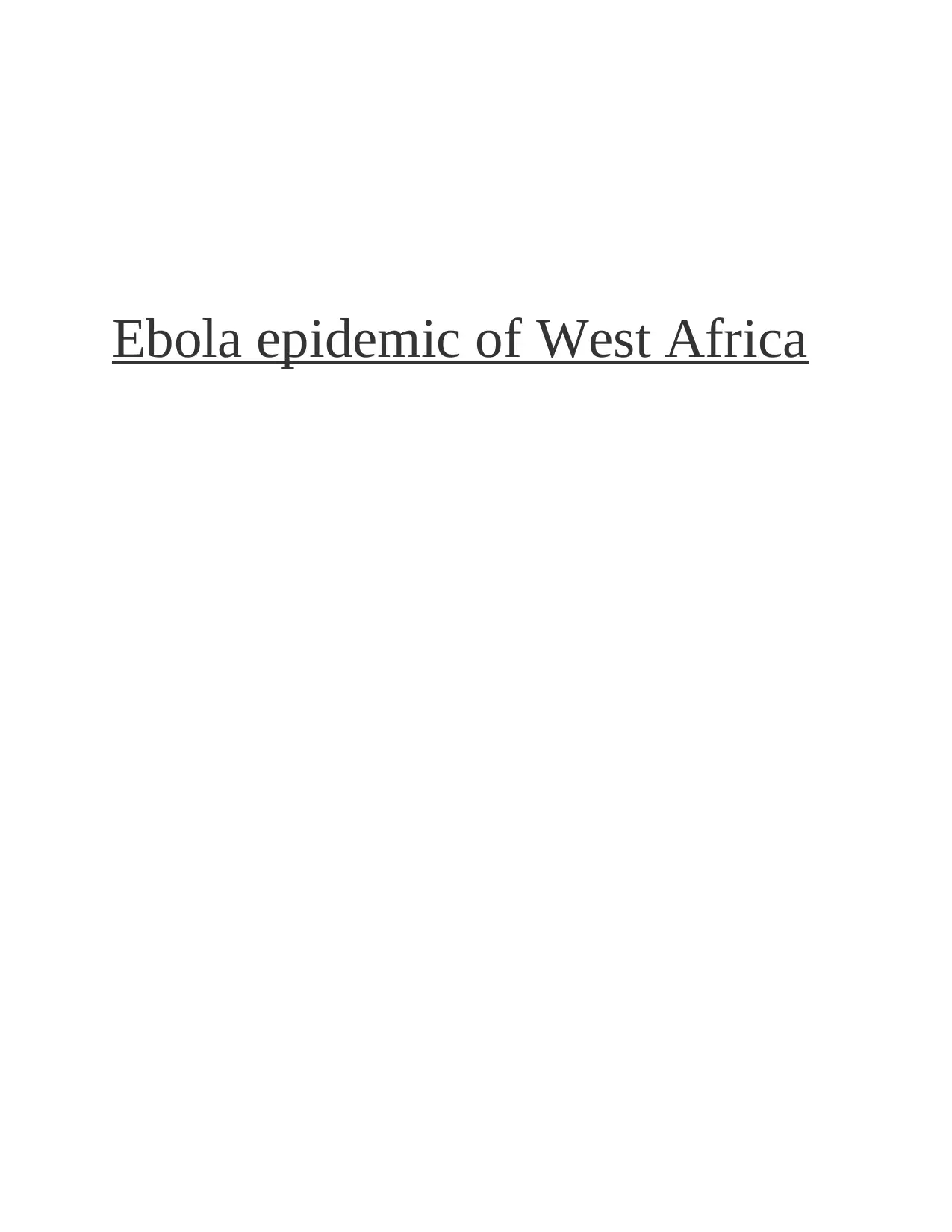
Ebola epidemic of West Africa
Paraphrase This Document
Need a fresh take? Get an instant paraphrase of this document with our AI Paraphraser
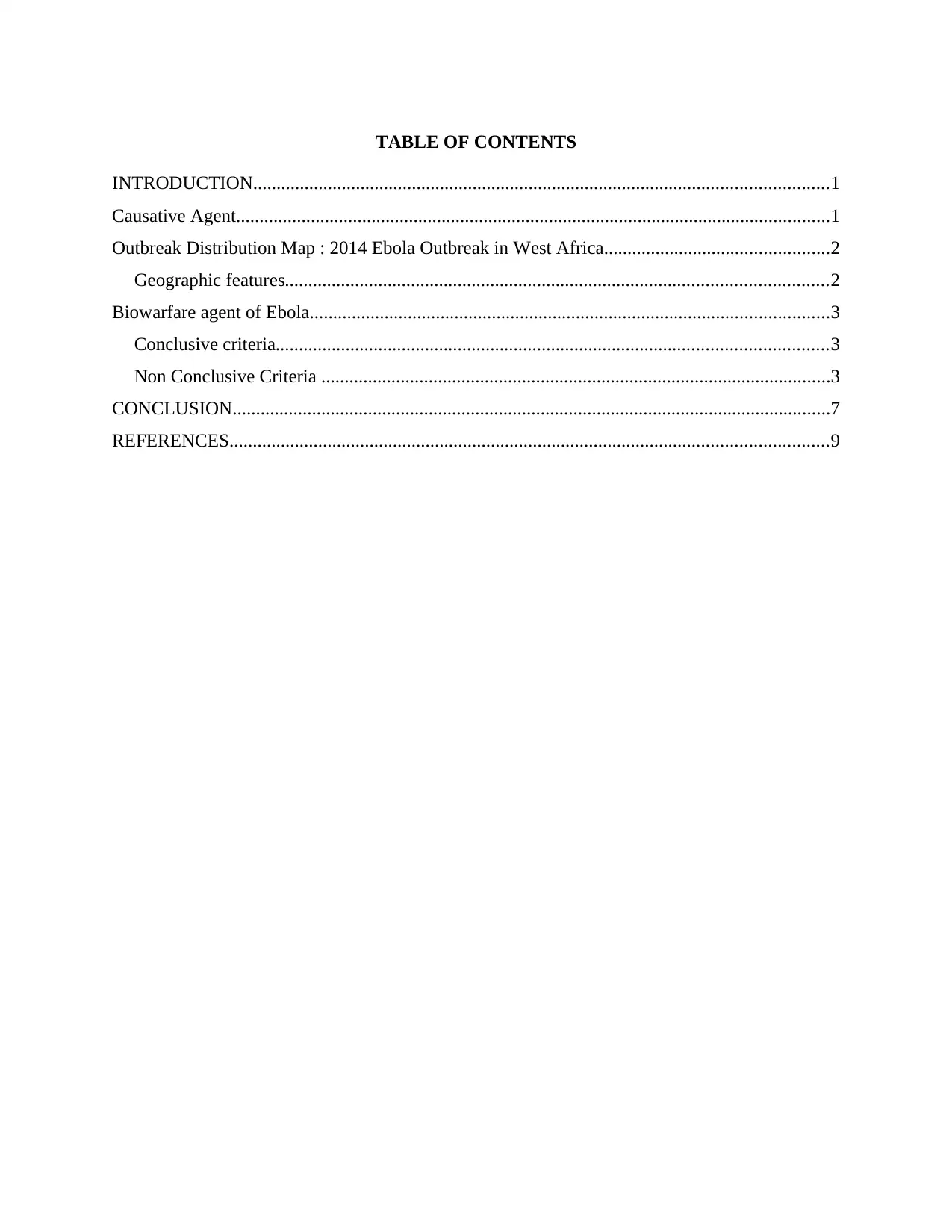
TABLE OF CONTENTS
INTRODUCTION...........................................................................................................................1
Causative Agent...............................................................................................................................1
Outbreak Distribution Map : 2014 Ebola Outbreak in West Africa................................................2
Geographic features....................................................................................................................2
Biowarfare agent of Ebola...............................................................................................................3
Conclusive criteria......................................................................................................................3
Non Conclusive Criteria .............................................................................................................3
CONCLUSION................................................................................................................................7
REFERENCES................................................................................................................................9
INTRODUCTION...........................................................................................................................1
Causative Agent...............................................................................................................................1
Outbreak Distribution Map : 2014 Ebola Outbreak in West Africa................................................2
Geographic features....................................................................................................................2
Biowarfare agent of Ebola...............................................................................................................3
Conclusive criteria......................................................................................................................3
Non Conclusive Criteria .............................................................................................................3
CONCLUSION................................................................................................................................7
REFERENCES................................................................................................................................9
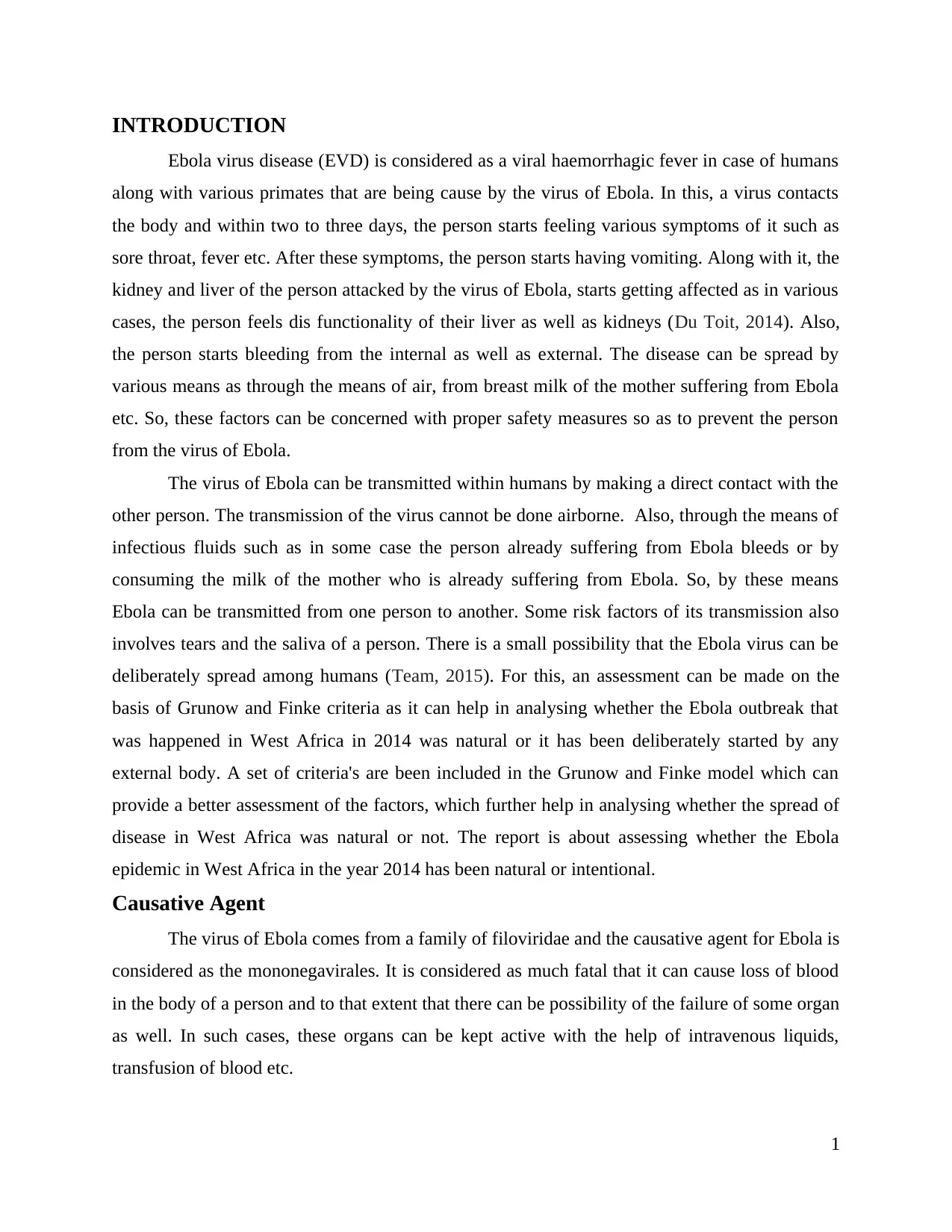
INTRODUCTION
Ebola virus disease (EVD) is considered as a viral haemorrhagic fever in case of humans
along with various primates that are being cause by the virus of Ebola. In this, a virus contacts
the body and within two to three days, the person starts feeling various symptoms of it such as
sore throat, fever etc. After these symptoms, the person starts having vomiting. Along with it, the
kidney and liver of the person attacked by the virus of Ebola, starts getting affected as in various
cases, the person feels dis functionality of their liver as well as kidneys (Du Toit, 2014). Also,
the person starts bleeding from the internal as well as external. The disease can be spread by
various means as through the means of air, from breast milk of the mother suffering from Ebola
etc. So, these factors can be concerned with proper safety measures so as to prevent the person
from the virus of Ebola.
The virus of Ebola can be transmitted within humans by making a direct contact with the
other person. The transmission of the virus cannot be done airborne. Also, through the means of
infectious fluids such as in some case the person already suffering from Ebola bleeds or by
consuming the milk of the mother who is already suffering from Ebola. So, by these means
Ebola can be transmitted from one person to another. Some risk factors of its transmission also
involves tears and the saliva of a person. There is a small possibility that the Ebola virus can be
deliberately spread among humans (Team, 2015). For this, an assessment can be made on the
basis of Grunow and Finke criteria as it can help in analysing whether the Ebola outbreak that
was happened in West Africa in 2014 was natural or it has been deliberately started by any
external body. A set of criteria's are been included in the Grunow and Finke model which can
provide a better assessment of the factors, which further help in analysing whether the spread of
disease in West Africa was natural or not. The report is about assessing whether the Ebola
epidemic in West Africa in the year 2014 has been natural or intentional.
Causative Agent
The virus of Ebola comes from a family of filoviridae and the causative agent for Ebola is
considered as the mononegavirales. It is considered as much fatal that it can cause loss of blood
in the body of a person and to that extent that there can be possibility of the failure of some organ
as well. In such cases, these organs can be kept active with the help of intravenous liquids,
transfusion of blood etc.
1
Ebola virus disease (EVD) is considered as a viral haemorrhagic fever in case of humans
along with various primates that are being cause by the virus of Ebola. In this, a virus contacts
the body and within two to three days, the person starts feeling various symptoms of it such as
sore throat, fever etc. After these symptoms, the person starts having vomiting. Along with it, the
kidney and liver of the person attacked by the virus of Ebola, starts getting affected as in various
cases, the person feels dis functionality of their liver as well as kidneys (Du Toit, 2014). Also,
the person starts bleeding from the internal as well as external. The disease can be spread by
various means as through the means of air, from breast milk of the mother suffering from Ebola
etc. So, these factors can be concerned with proper safety measures so as to prevent the person
from the virus of Ebola.
The virus of Ebola can be transmitted within humans by making a direct contact with the
other person. The transmission of the virus cannot be done airborne. Also, through the means of
infectious fluids such as in some case the person already suffering from Ebola bleeds or by
consuming the milk of the mother who is already suffering from Ebola. So, by these means
Ebola can be transmitted from one person to another. Some risk factors of its transmission also
involves tears and the saliva of a person. There is a small possibility that the Ebola virus can be
deliberately spread among humans (Team, 2015). For this, an assessment can be made on the
basis of Grunow and Finke criteria as it can help in analysing whether the Ebola outbreak that
was happened in West Africa in 2014 was natural or it has been deliberately started by any
external body. A set of criteria's are been included in the Grunow and Finke model which can
provide a better assessment of the factors, which further help in analysing whether the spread of
disease in West Africa was natural or not. The report is about assessing whether the Ebola
epidemic in West Africa in the year 2014 has been natural or intentional.
Causative Agent
The virus of Ebola comes from a family of filoviridae and the causative agent for Ebola is
considered as the mononegavirales. It is considered as much fatal that it can cause loss of blood
in the body of a person and to that extent that there can be possibility of the failure of some organ
as well. In such cases, these organs can be kept active with the help of intravenous liquids,
transfusion of blood etc.
1
⊘ This is a preview!⊘
Do you want full access?
Subscribe today to unlock all pages.

Trusted by 1+ million students worldwide
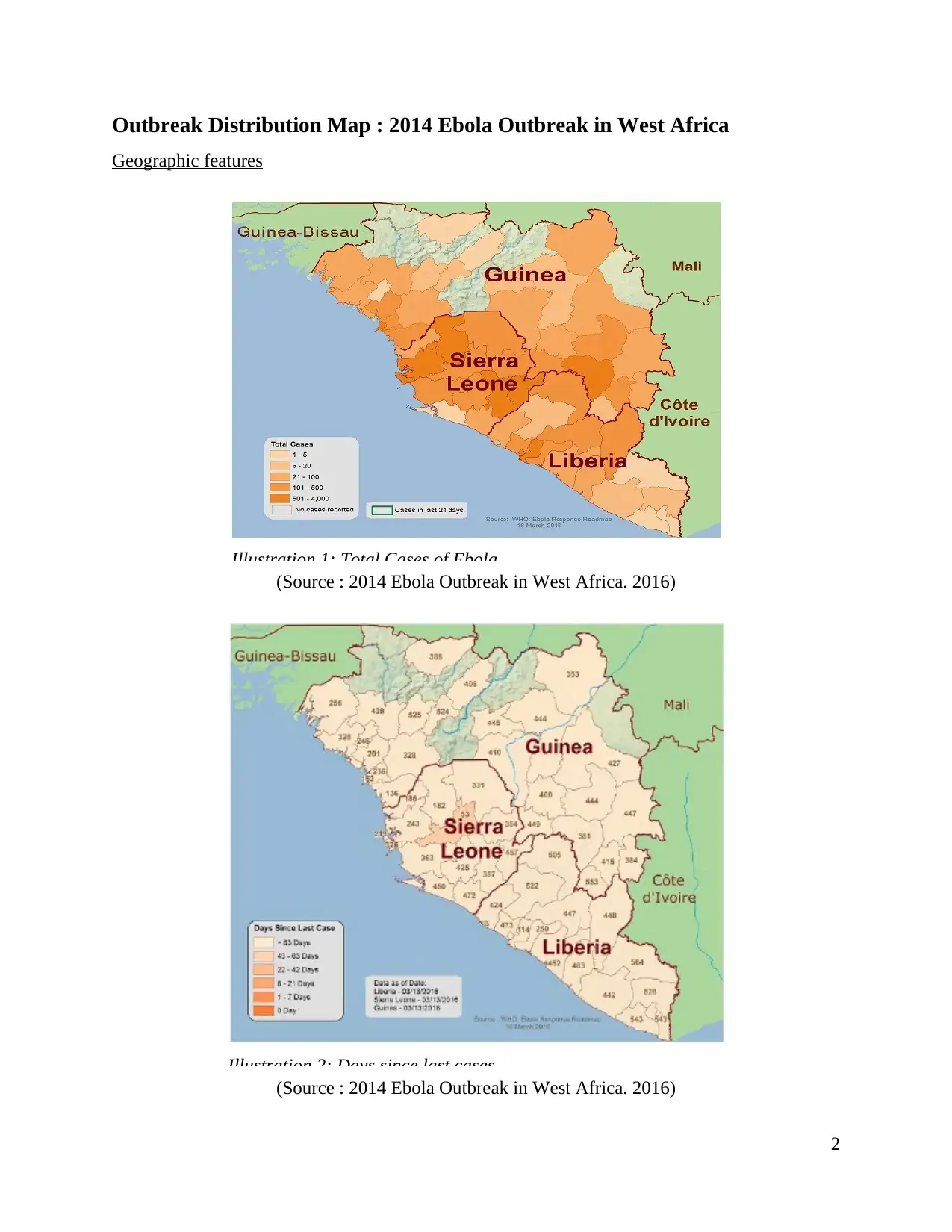
Outbreak Distribution Map : 2014 Ebola Outbreak in West Africa
Geographic features
(Source : 2014 Ebola Outbreak in West Africa. 2016)
(Source : 2014 Ebola Outbreak in West Africa. 2016)
2
Illustration 1: Total Cases of Ebola
Illustration 2: Days since last cases
Geographic features
(Source : 2014 Ebola Outbreak in West Africa. 2016)
(Source : 2014 Ebola Outbreak in West Africa. 2016)
2
Illustration 1: Total Cases of Ebola
Illustration 2: Days since last cases
Paraphrase This Document
Need a fresh take? Get an instant paraphrase of this document with our AI Paraphraser
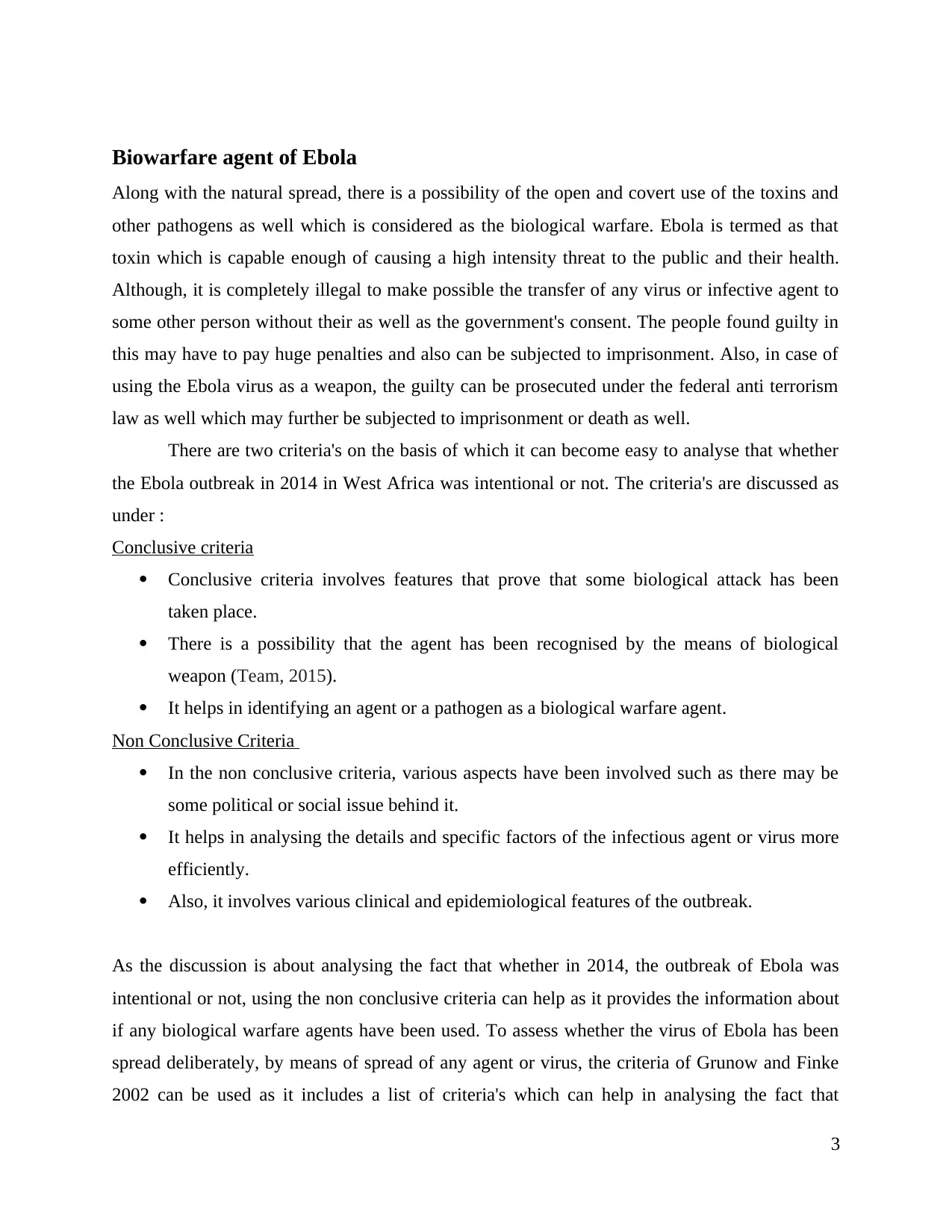
Biowarfare agent of Ebola
Along with the natural spread, there is a possibility of the open and covert use of the toxins and
other pathogens as well which is considered as the biological warfare. Ebola is termed as that
toxin which is capable enough of causing a high intensity threat to the public and their health.
Although, it is completely illegal to make possible the transfer of any virus or infective agent to
some other person without their as well as the government's consent. The people found guilty in
this may have to pay huge penalties and also can be subjected to imprisonment. Also, in case of
using the Ebola virus as a weapon, the guilty can be prosecuted under the federal anti terrorism
law as well which may further be subjected to imprisonment or death as well.
There are two criteria's on the basis of which it can become easy to analyse that whether
the Ebola outbreak in 2014 in West Africa was intentional or not. The criteria's are discussed as
under :
Conclusive criteria
Conclusive criteria involves features that prove that some biological attack has been
taken place.
There is a possibility that the agent has been recognised by the means of biological
weapon (Team, 2015).
It helps in identifying an agent or a pathogen as a biological warfare agent.
Non Conclusive Criteria
In the non conclusive criteria, various aspects have been involved such as there may be
some political or social issue behind it.
It helps in analysing the details and specific factors of the infectious agent or virus more
efficiently.
Also, it involves various clinical and epidemiological features of the outbreak.
As the discussion is about analysing the fact that whether in 2014, the outbreak of Ebola was
intentional or not, using the non conclusive criteria can help as it provides the information about
if any biological warfare agents have been used. To assess whether the virus of Ebola has been
spread deliberately, by means of spread of any agent or virus, the criteria of Grunow and Finke
2002 can be used as it includes a list of criteria's which can help in analysing the fact that
3
Along with the natural spread, there is a possibility of the open and covert use of the toxins and
other pathogens as well which is considered as the biological warfare. Ebola is termed as that
toxin which is capable enough of causing a high intensity threat to the public and their health.
Although, it is completely illegal to make possible the transfer of any virus or infective agent to
some other person without their as well as the government's consent. The people found guilty in
this may have to pay huge penalties and also can be subjected to imprisonment. Also, in case of
using the Ebola virus as a weapon, the guilty can be prosecuted under the federal anti terrorism
law as well which may further be subjected to imprisonment or death as well.
There are two criteria's on the basis of which it can become easy to analyse that whether
the Ebola outbreak in 2014 in West Africa was intentional or not. The criteria's are discussed as
under :
Conclusive criteria
Conclusive criteria involves features that prove that some biological attack has been
taken place.
There is a possibility that the agent has been recognised by the means of biological
weapon (Team, 2015).
It helps in identifying an agent or a pathogen as a biological warfare agent.
Non Conclusive Criteria
In the non conclusive criteria, various aspects have been involved such as there may be
some political or social issue behind it.
It helps in analysing the details and specific factors of the infectious agent or virus more
efficiently.
Also, it involves various clinical and epidemiological features of the outbreak.
As the discussion is about analysing the fact that whether in 2014, the outbreak of Ebola was
intentional or not, using the non conclusive criteria can help as it provides the information about
if any biological warfare agents have been used. To assess whether the virus of Ebola has been
spread deliberately, by means of spread of any agent or virus, the criteria of Grunow and Finke
2002 can be used as it includes a list of criteria's which can help in analysing the fact that
3
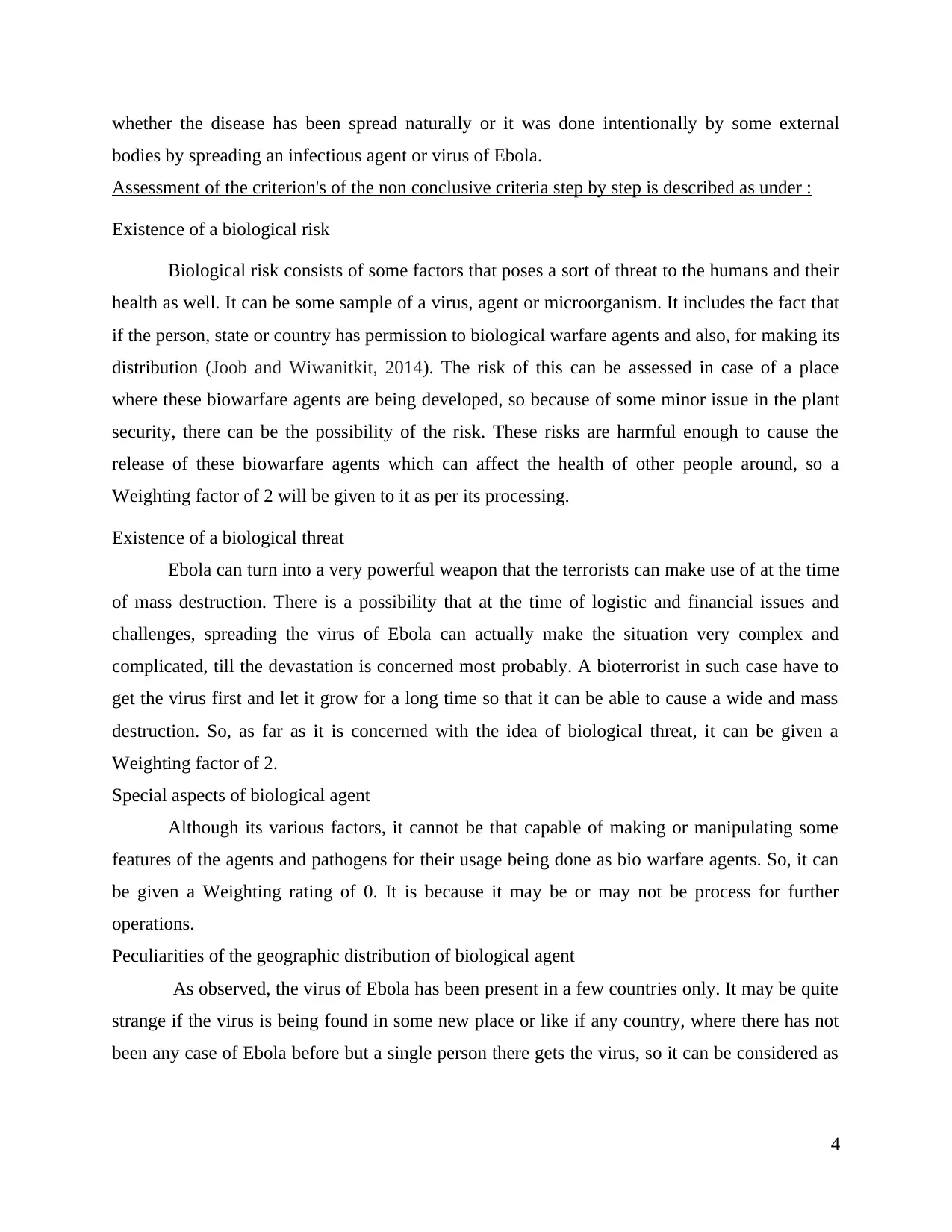
whether the disease has been spread naturally or it was done intentionally by some external
bodies by spreading an infectious agent or virus of Ebola.
Assessment of the criterion's of the non conclusive criteria step by step is described as under :
Existence of a biological risk
Biological risk consists of some factors that poses a sort of threat to the humans and their
health as well. It can be some sample of a virus, agent or microorganism. It includes the fact that
if the person, state or country has permission to biological warfare agents and also, for making its
distribution (Joob and Wiwanitkit, 2014). The risk of this can be assessed in case of a place
where these biowarfare agents are being developed, so because of some minor issue in the plant
security, there can be the possibility of the risk. These risks are harmful enough to cause the
release of these biowarfare agents which can affect the health of other people around, so a
Weighting factor of 2 will be given to it as per its processing.
Existence of a biological threat
Ebola can turn into a very powerful weapon that the terrorists can make use of at the time
of mass destruction. There is a possibility that at the time of logistic and financial issues and
challenges, spreading the virus of Ebola can actually make the situation very complex and
complicated, till the devastation is concerned most probably. A bioterrorist in such case have to
get the virus first and let it grow for a long time so that it can be able to cause a wide and mass
destruction. So, as far as it is concerned with the idea of biological threat, it can be given a
Weighting factor of 2.
Special aspects of biological agent
Although its various factors, it cannot be that capable of making or manipulating some
features of the agents and pathogens for their usage being done as bio warfare agents. So, it can
be given a Weighting rating of 0. It is because it may be or may not be process for further
operations.
Peculiarities of the geographic distribution of biological agent
As observed, the virus of Ebola has been present in a few countries only. It may be quite
strange if the virus is being found in some new place or like if any country, where there has not
been any case of Ebola before but a single person there gets the virus, so it can be considered as
4
bodies by spreading an infectious agent or virus of Ebola.
Assessment of the criterion's of the non conclusive criteria step by step is described as under :
Existence of a biological risk
Biological risk consists of some factors that poses a sort of threat to the humans and their
health as well. It can be some sample of a virus, agent or microorganism. It includes the fact that
if the person, state or country has permission to biological warfare agents and also, for making its
distribution (Joob and Wiwanitkit, 2014). The risk of this can be assessed in case of a place
where these biowarfare agents are being developed, so because of some minor issue in the plant
security, there can be the possibility of the risk. These risks are harmful enough to cause the
release of these biowarfare agents which can affect the health of other people around, so a
Weighting factor of 2 will be given to it as per its processing.
Existence of a biological threat
Ebola can turn into a very powerful weapon that the terrorists can make use of at the time
of mass destruction. There is a possibility that at the time of logistic and financial issues and
challenges, spreading the virus of Ebola can actually make the situation very complex and
complicated, till the devastation is concerned most probably. A bioterrorist in such case have to
get the virus first and let it grow for a long time so that it can be able to cause a wide and mass
destruction. So, as far as it is concerned with the idea of biological threat, it can be given a
Weighting factor of 2.
Special aspects of biological agent
Although its various factors, it cannot be that capable of making or manipulating some
features of the agents and pathogens for their usage being done as bio warfare agents. So, it can
be given a Weighting rating of 0. It is because it may be or may not be process for further
operations.
Peculiarities of the geographic distribution of biological agent
As observed, the virus of Ebola has been present in a few countries only. It may be quite
strange if the virus is being found in some new place or like if any country, where there has not
been any case of Ebola before but a single person there gets the virus, so it can be considered as
4
⊘ This is a preview!⊘
Do you want full access?
Subscribe today to unlock all pages.

Trusted by 1+ million students worldwide
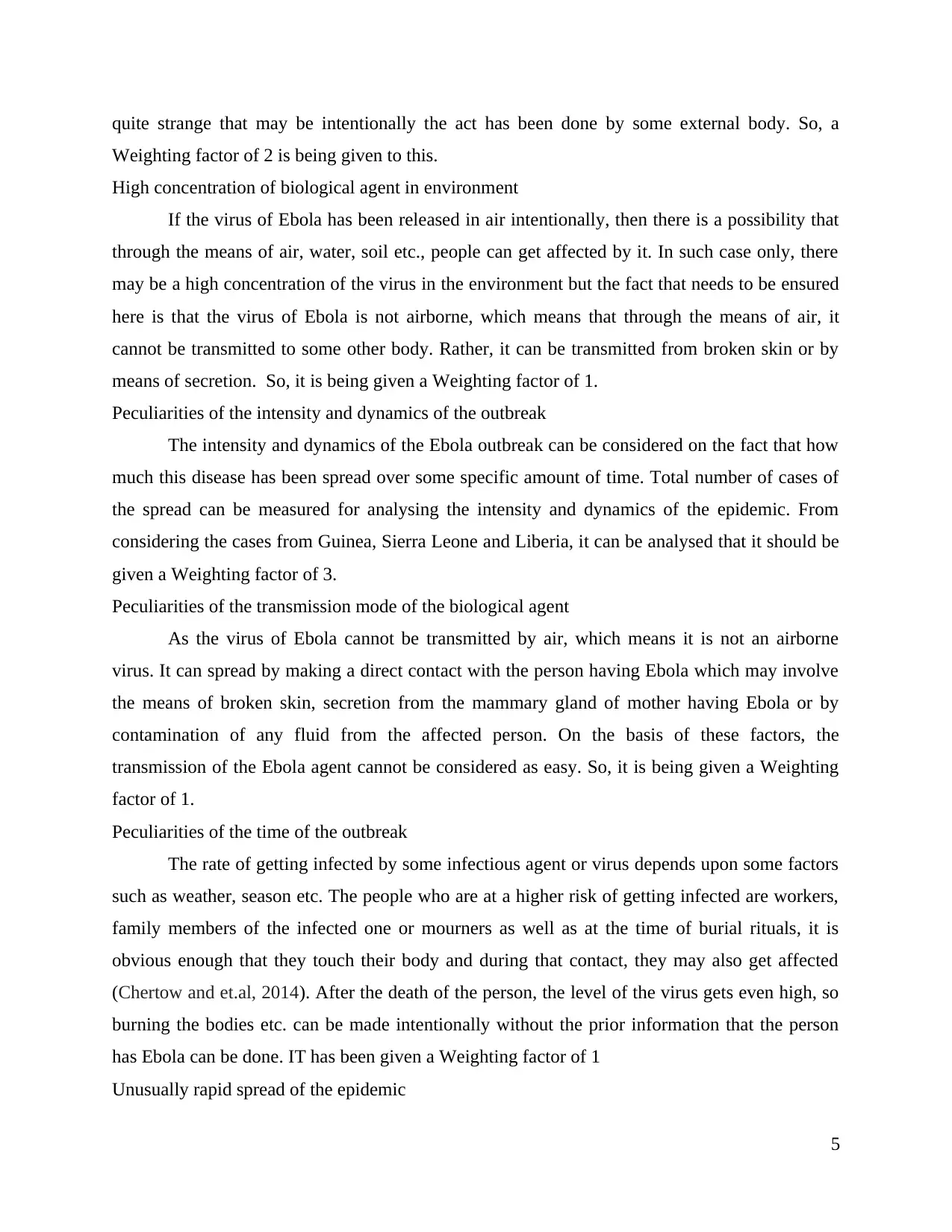
quite strange that may be intentionally the act has been done by some external body. So, a
Weighting factor of 2 is being given to this.
High concentration of biological agent in environment
If the virus of Ebola has been released in air intentionally, then there is a possibility that
through the means of air, water, soil etc., people can get affected by it. In such case only, there
may be a high concentration of the virus in the environment but the fact that needs to be ensured
here is that the virus of Ebola is not airborne, which means that through the means of air, it
cannot be transmitted to some other body. Rather, it can be transmitted from broken skin or by
means of secretion. So, it is being given a Weighting factor of 1.
Peculiarities of the intensity and dynamics of the outbreak
The intensity and dynamics of the Ebola outbreak can be considered on the fact that how
much this disease has been spread over some specific amount of time. Total number of cases of
the spread can be measured for analysing the intensity and dynamics of the epidemic. From
considering the cases from Guinea, Sierra Leone and Liberia, it can be analysed that it should be
given a Weighting factor of 3.
Peculiarities of the transmission mode of the biological agent
As the virus of Ebola cannot be transmitted by air, which means it is not an airborne
virus. It can spread by making a direct contact with the person having Ebola which may involve
the means of broken skin, secretion from the mammary gland of mother having Ebola or by
contamination of any fluid from the affected person. On the basis of these factors, the
transmission of the Ebola agent cannot be considered as easy. So, it is being given a Weighting
factor of 1.
Peculiarities of the time of the outbreak
The rate of getting infected by some infectious agent or virus depends upon some factors
such as weather, season etc. The people who are at a higher risk of getting infected are workers,
family members of the infected one or mourners as well as at the time of burial rituals, it is
obvious enough that they touch their body and during that contact, they may also get affected
(Chertow and et.al, 2014). After the death of the person, the level of the virus gets even high, so
burning the bodies etc. can be made intentionally without the prior information that the person
has Ebola can be done. IT has been given a Weighting factor of 1
Unusually rapid spread of the epidemic
5
Weighting factor of 2 is being given to this.
High concentration of biological agent in environment
If the virus of Ebola has been released in air intentionally, then there is a possibility that
through the means of air, water, soil etc., people can get affected by it. In such case only, there
may be a high concentration of the virus in the environment but the fact that needs to be ensured
here is that the virus of Ebola is not airborne, which means that through the means of air, it
cannot be transmitted to some other body. Rather, it can be transmitted from broken skin or by
means of secretion. So, it is being given a Weighting factor of 1.
Peculiarities of the intensity and dynamics of the outbreak
The intensity and dynamics of the Ebola outbreak can be considered on the fact that how
much this disease has been spread over some specific amount of time. Total number of cases of
the spread can be measured for analysing the intensity and dynamics of the epidemic. From
considering the cases from Guinea, Sierra Leone and Liberia, it can be analysed that it should be
given a Weighting factor of 3.
Peculiarities of the transmission mode of the biological agent
As the virus of Ebola cannot be transmitted by air, which means it is not an airborne
virus. It can spread by making a direct contact with the person having Ebola which may involve
the means of broken skin, secretion from the mammary gland of mother having Ebola or by
contamination of any fluid from the affected person. On the basis of these factors, the
transmission of the Ebola agent cannot be considered as easy. So, it is being given a Weighting
factor of 1.
Peculiarities of the time of the outbreak
The rate of getting infected by some infectious agent or virus depends upon some factors
such as weather, season etc. The people who are at a higher risk of getting infected are workers,
family members of the infected one or mourners as well as at the time of burial rituals, it is
obvious enough that they touch their body and during that contact, they may also get affected
(Chertow and et.al, 2014). After the death of the person, the level of the virus gets even high, so
burning the bodies etc. can be made intentionally without the prior information that the person
has Ebola can be done. IT has been given a Weighting factor of 1
Unusually rapid spread of the epidemic
5
Paraphrase This Document
Need a fresh take? Get an instant paraphrase of this document with our AI Paraphraser
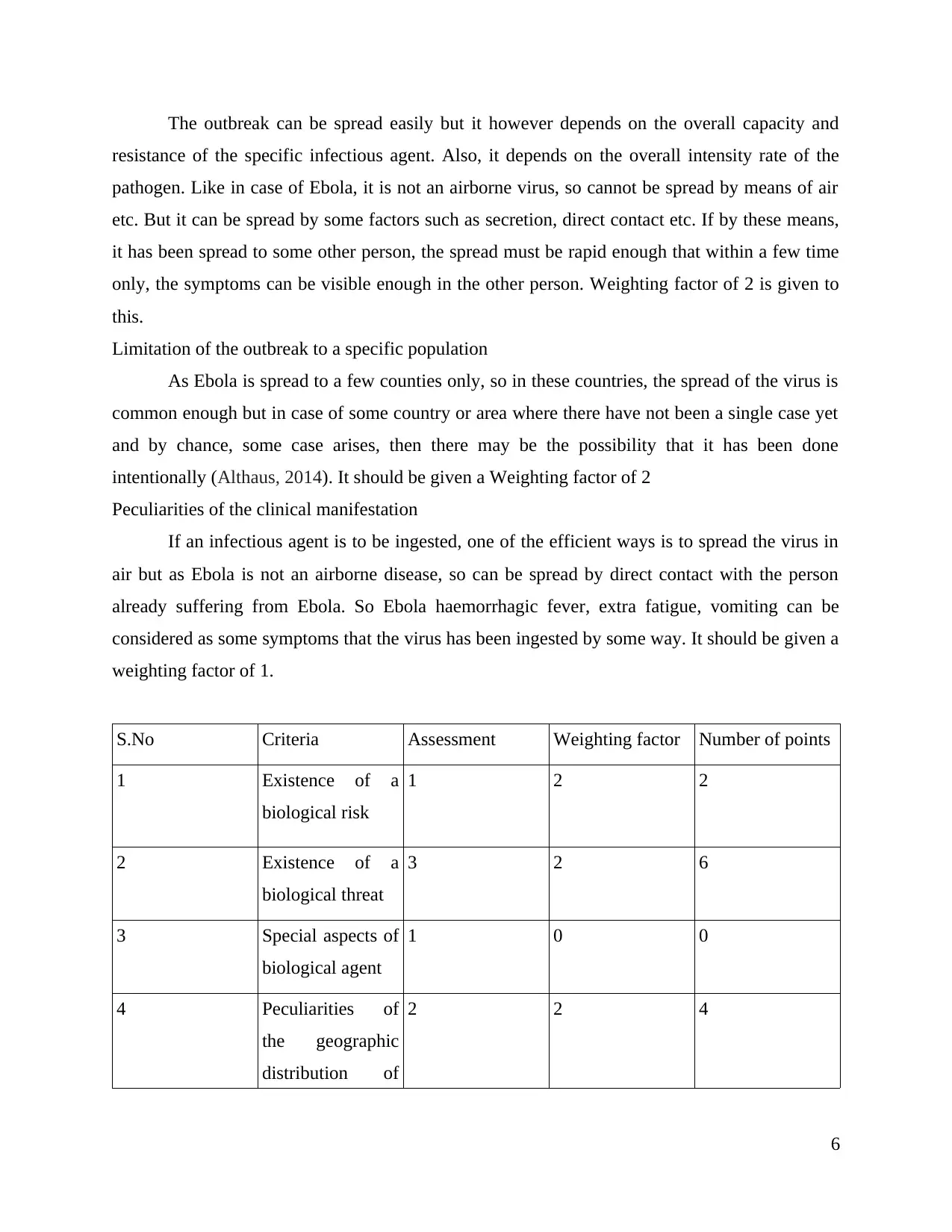
The outbreak can be spread easily but it however depends on the overall capacity and
resistance of the specific infectious agent. Also, it depends on the overall intensity rate of the
pathogen. Like in case of Ebola, it is not an airborne virus, so cannot be spread by means of air
etc. But it can be spread by some factors such as secretion, direct contact etc. If by these means,
it has been spread to some other person, the spread must be rapid enough that within a few time
only, the symptoms can be visible enough in the other person. Weighting factor of 2 is given to
this.
Limitation of the outbreak to a specific population
As Ebola is spread to a few counties only, so in these countries, the spread of the virus is
common enough but in case of some country or area where there have not been a single case yet
and by chance, some case arises, then there may be the possibility that it has been done
intentionally (Althaus, 2014). It should be given a Weighting factor of 2
Peculiarities of the clinical manifestation
If an infectious agent is to be ingested, one of the efficient ways is to spread the virus in
air but as Ebola is not an airborne disease, so can be spread by direct contact with the person
already suffering from Ebola. So Ebola haemorrhagic fever, extra fatigue, vomiting can be
considered as some symptoms that the virus has been ingested by some way. It should be given a
weighting factor of 1.
S.No Criteria Assessment Weighting factor Number of points
1 Existence of a
biological risk
1 2 2
2 Existence of a
biological threat
3 2 6
3 Special aspects of
biological agent
1 0 0
4 Peculiarities of
the geographic
distribution of
2 2 4
6
resistance of the specific infectious agent. Also, it depends on the overall intensity rate of the
pathogen. Like in case of Ebola, it is not an airborne virus, so cannot be spread by means of air
etc. But it can be spread by some factors such as secretion, direct contact etc. If by these means,
it has been spread to some other person, the spread must be rapid enough that within a few time
only, the symptoms can be visible enough in the other person. Weighting factor of 2 is given to
this.
Limitation of the outbreak to a specific population
As Ebola is spread to a few counties only, so in these countries, the spread of the virus is
common enough but in case of some country or area where there have not been a single case yet
and by chance, some case arises, then there may be the possibility that it has been done
intentionally (Althaus, 2014). It should be given a Weighting factor of 2
Peculiarities of the clinical manifestation
If an infectious agent is to be ingested, one of the efficient ways is to spread the virus in
air but as Ebola is not an airborne disease, so can be spread by direct contact with the person
already suffering from Ebola. So Ebola haemorrhagic fever, extra fatigue, vomiting can be
considered as some symptoms that the virus has been ingested by some way. It should be given a
weighting factor of 1.
S.No Criteria Assessment Weighting factor Number of points
1 Existence of a
biological risk
1 2 2
2 Existence of a
biological threat
3 2 6
3 Special aspects of
biological agent
1 0 0
4 Peculiarities of
the geographic
distribution of
2 2 4
6
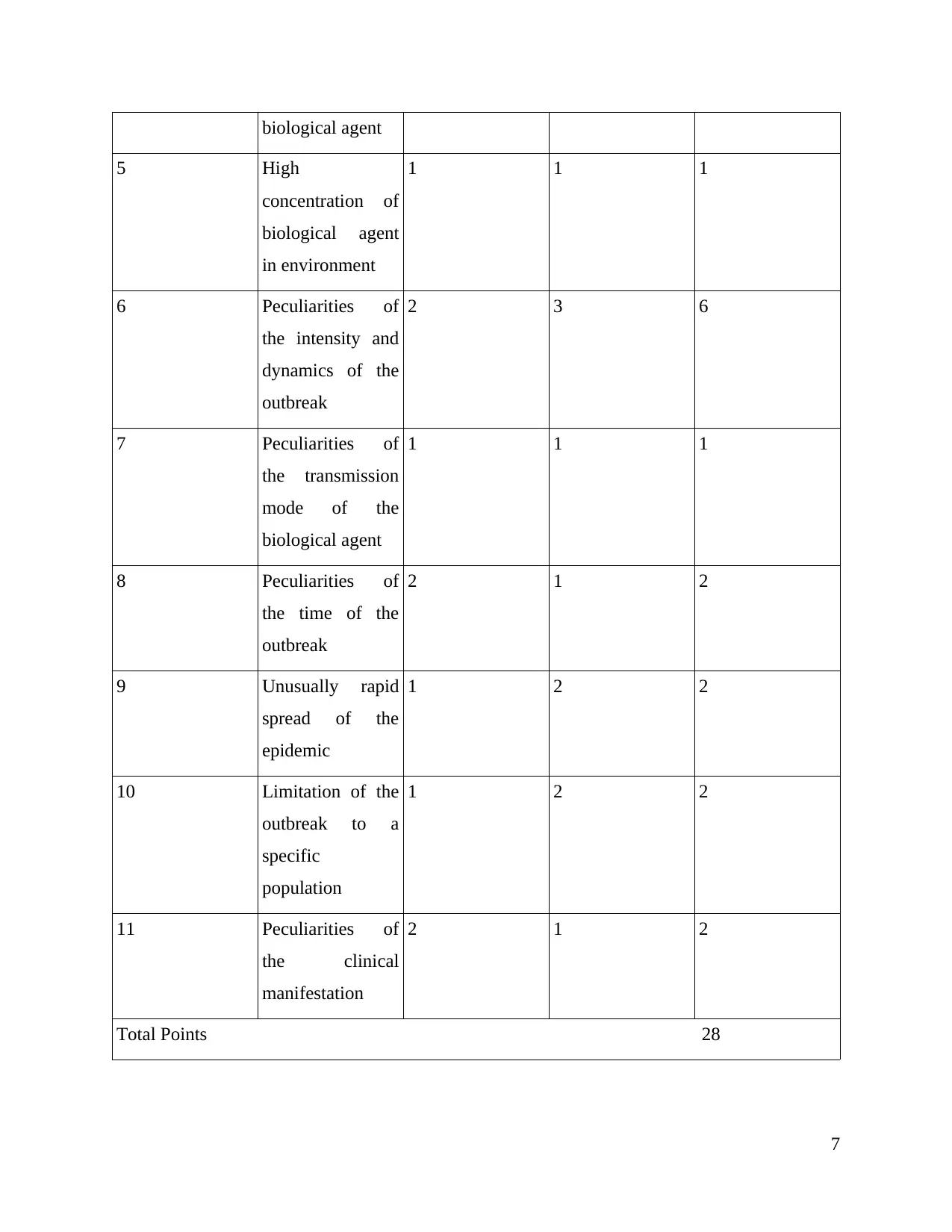
biological agent
5 High
concentration of
biological agent
in environment
1 1 1
6 Peculiarities of
the intensity and
dynamics of the
outbreak
2 3 6
7 Peculiarities of
the transmission
mode of the
biological agent
1 1 1
8 Peculiarities of
the time of the
outbreak
2 1 2
9 Unusually rapid
spread of the
epidemic
1 2 2
10 Limitation of the
outbreak to a
specific
population
1 2 2
11 Peculiarities of
the clinical
manifestation
2 1 2
Total Points 28
7
5 High
concentration of
biological agent
in environment
1 1 1
6 Peculiarities of
the intensity and
dynamics of the
outbreak
2 3 6
7 Peculiarities of
the transmission
mode of the
biological agent
1 1 1
8 Peculiarities of
the time of the
outbreak
2 1 2
9 Unusually rapid
spread of the
epidemic
1 2 2
10 Limitation of the
outbreak to a
specific
population
1 2 2
11 Peculiarities of
the clinical
manifestation
2 1 2
Total Points 28
7
⊘ This is a preview!⊘
Do you want full access?
Subscribe today to unlock all pages.

Trusted by 1+ million students worldwide
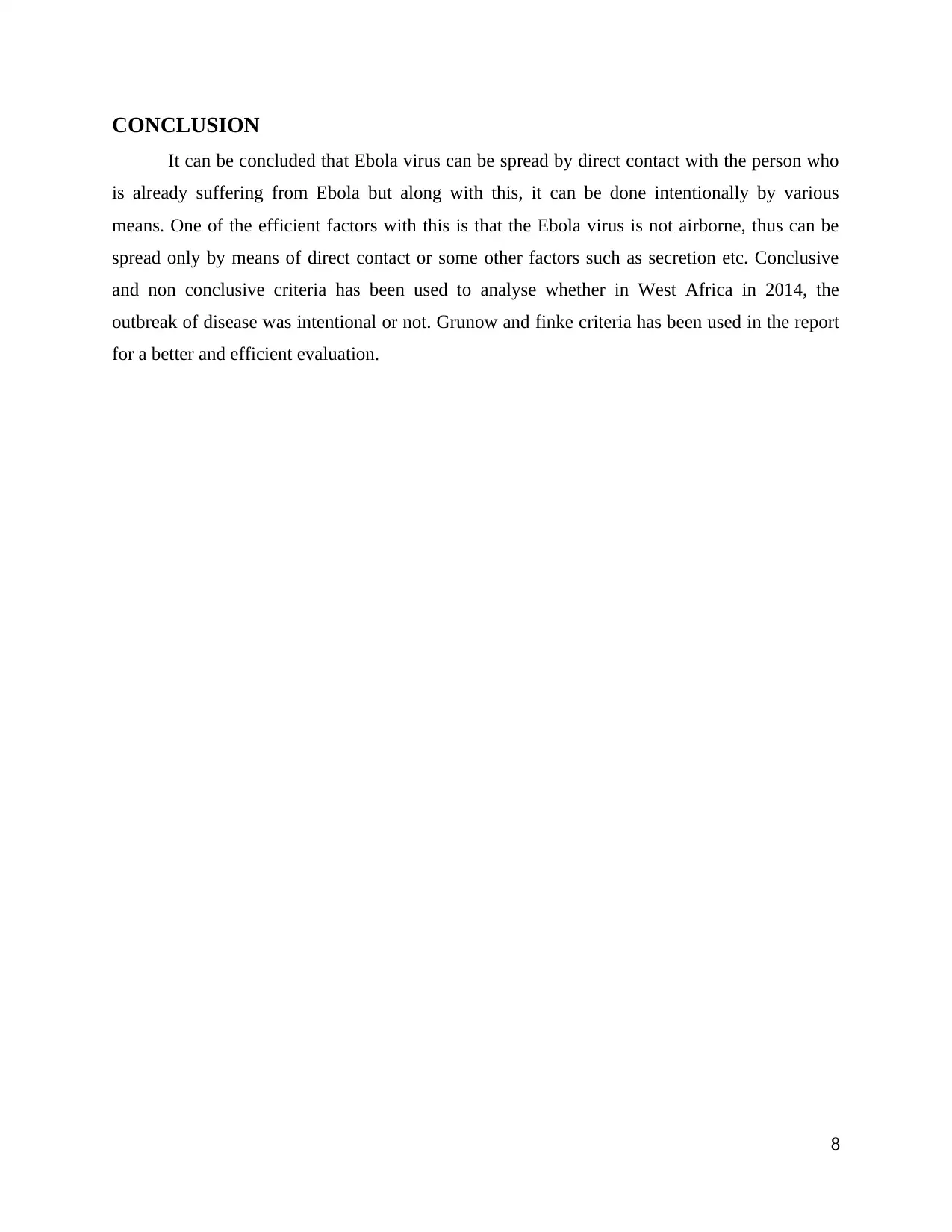
CONCLUSION
It can be concluded that Ebola virus can be spread by direct contact with the person who
is already suffering from Ebola but along with this, it can be done intentionally by various
means. One of the efficient factors with this is that the Ebola virus is not airborne, thus can be
spread only by means of direct contact or some other factors such as secretion etc. Conclusive
and non conclusive criteria has been used to analyse whether in West Africa in 2014, the
outbreak of disease was intentional or not. Grunow and finke criteria has been used in the report
for a better and efficient evaluation.
8
It can be concluded that Ebola virus can be spread by direct contact with the person who
is already suffering from Ebola but along with this, it can be done intentionally by various
means. One of the efficient factors with this is that the Ebola virus is not airborne, thus can be
spread only by means of direct contact or some other factors such as secretion etc. Conclusive
and non conclusive criteria has been used to analyse whether in West Africa in 2014, the
outbreak of disease was intentional or not. Grunow and finke criteria has been used in the report
for a better and efficient evaluation.
8
Paraphrase This Document
Need a fresh take? Get an instant paraphrase of this document with our AI Paraphraser
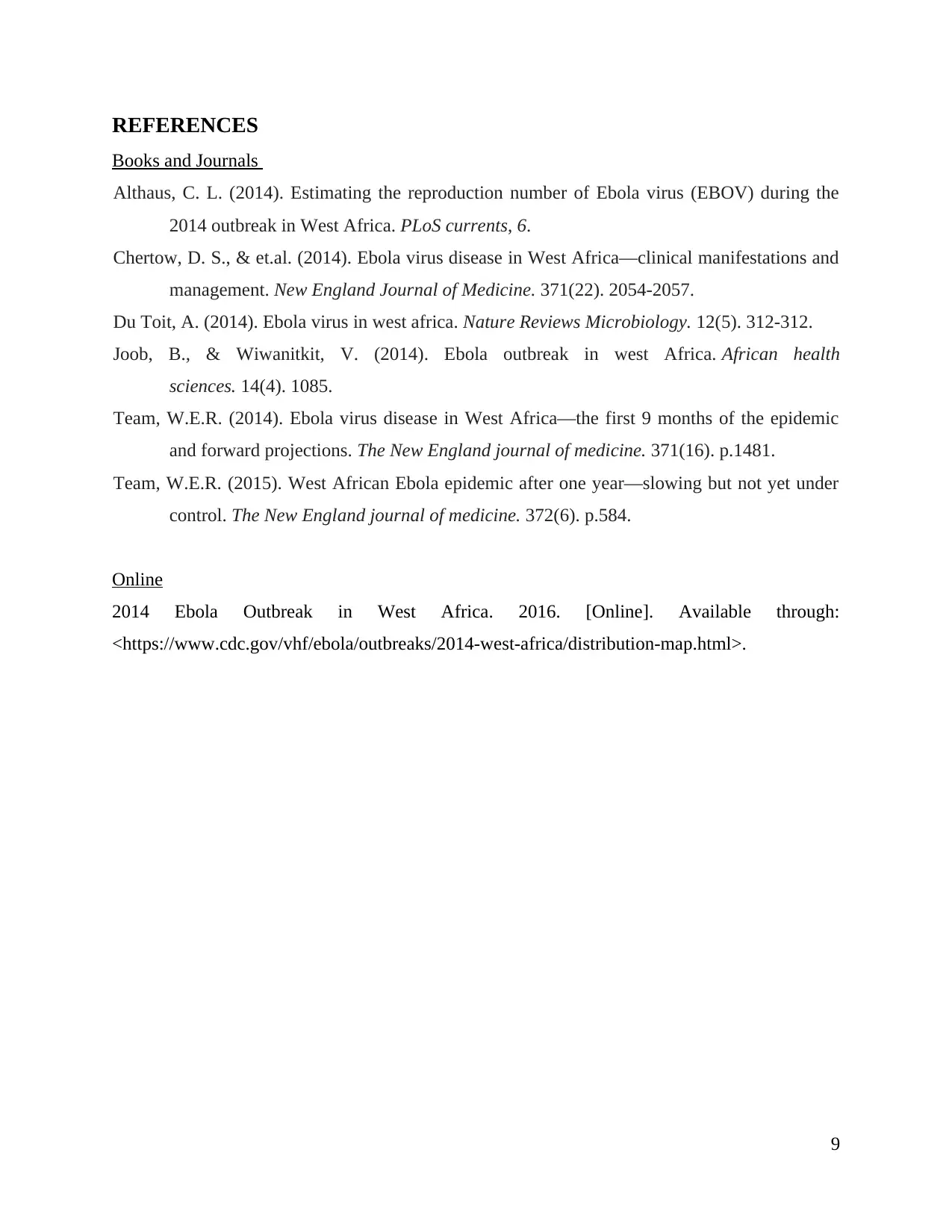
REFERENCES
Books and Journals
Althaus, C. L. (2014). Estimating the reproduction number of Ebola virus (EBOV) during the
2014 outbreak in West Africa. PLoS currents, 6.
Chertow, D. S., & et.al. (2014). Ebola virus disease in West Africa—clinical manifestations and
management. New England Journal of Medicine. 371(22). 2054-2057.
Du Toit, A. (2014). Ebola virus in west africa. Nature Reviews Microbiology. 12(5). 312-312.
Joob, B., & Wiwanitkit, V. (2014). Ebola outbreak in west Africa. African health
sciences. 14(4). 1085.
Team, W.E.R. (2014). Ebola virus disease in West Africa—the first 9 months of the epidemic
and forward projections. The New England journal of medicine. 371(16). p.1481.
Team, W.E.R. (2015). West African Ebola epidemic after one year—slowing but not yet under
control. The New England journal of medicine. 372(6). p.584.
Online
2014 Ebola Outbreak in West Africa. 2016. [Online]. Available through:
<https://www.cdc.gov/vhf/ebola/outbreaks/2014-west-africa/distribution-map.html>.
9
Books and Journals
Althaus, C. L. (2014). Estimating the reproduction number of Ebola virus (EBOV) during the
2014 outbreak in West Africa. PLoS currents, 6.
Chertow, D. S., & et.al. (2014). Ebola virus disease in West Africa—clinical manifestations and
management. New England Journal of Medicine. 371(22). 2054-2057.
Du Toit, A. (2014). Ebola virus in west africa. Nature Reviews Microbiology. 12(5). 312-312.
Joob, B., & Wiwanitkit, V. (2014). Ebola outbreak in west Africa. African health
sciences. 14(4). 1085.
Team, W.E.R. (2014). Ebola virus disease in West Africa—the first 9 months of the epidemic
and forward projections. The New England journal of medicine. 371(16). p.1481.
Team, W.E.R. (2015). West African Ebola epidemic after one year—slowing but not yet under
control. The New England journal of medicine. 372(6). p.584.
Online
2014 Ebola Outbreak in West Africa. 2016. [Online]. Available through:
<https://www.cdc.gov/vhf/ebola/outbreaks/2014-west-africa/distribution-map.html>.
9
1 out of 11
Related Documents
Your All-in-One AI-Powered Toolkit for Academic Success.
+13062052269
info@desklib.com
Available 24*7 on WhatsApp / Email
![[object Object]](/_next/static/media/star-bottom.7253800d.svg)
Unlock your academic potential
Copyright © 2020–2025 A2Z Services. All Rights Reserved. Developed and managed by ZUCOL.





